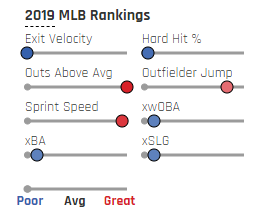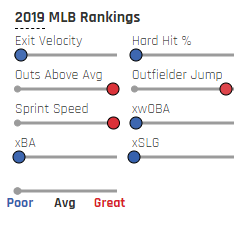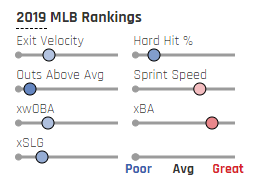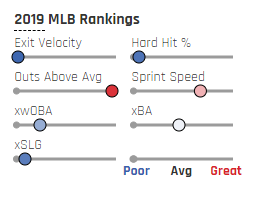With the MLB season suspended, many fantasy drafts have also been postponed. For those with drafts yet to come, the quarantine has provided ample time to revamp and fine tune your 2020 draft strategy. What we do know is that the season is likely to be somewhat shorter. 140 games? 100 games? Who knows. Drawing conclusions on the shortened season’s fantasy impact is highly speculative at this time. I generally feel the same way about these guys now that I did before the delay and shorter season, but I’ll weave in minor commentary on how the delayed start may impact my targets and fades. Another point of note: I’ll also be referring to numbers and statistics assuming a full 162 game season for easier understanding, since that’s what we’re used to.
My rules for this piece are as follows: Target = someone being drafted too late. Fade = someone being drafted too early. The goal is not to declare the targets will be MVPs or the fades to be DFA’d. The final rule is that I broke the top 250 NFBC March 2020 ADP into five equal groups of 50. I chose one target and one fade from each group. Here we go.
Group 1: ADP 1-50
FADE: Pete Alonso (ADP 32): Alonso’s 2019 break-out was irrefutably incredible. But in an era where Eduardo Escobar is hitting 35 dingers, power is plentiful and should be discounted. There are a few reasons why pick 32 is too rich for the Polar Bear. Pitchers have had an entire off season to study Alonso. It’s common for second year players to take a step back in performance following break-outs. That doesn’t mean they become irrelevant, but rookie success at super elite levels is tough to sustain. Look at Cody Bellinger for instance. Following a huge break-out rookie year, Bellinger’s performance tempered in his sophomore campaign as pitchers had more scouting reports to work with.
| PA | HR | R | RBI | AVG | SLG | |
|---|---|---|---|---|---|---|
| 2017 | 548 | 39 | 87 | 97 | 0.267 | 0.581 |
| 2018 | 632 | 25 | 84 | 76 | 0.260 | 0.470 |
Alonso ranked 4th in 2019 with a 30.6% HR/FB rate. Even in his minor league career, Alonso never topped 28.5% at any level in a given year. This rate would have ranked 2nd in the league in 2018. This will regress in 2020 and the 53 home runs becomes 43 assuming a 25% HR/FB rate. 25% is still elite and would have ranked 14th in the MLB ahead of Ronald Acuna and Cody Bellinger. Furthermore, if you assume Alonso plays 151 games instead of 161, the 43 homers dips to 41. Everything broke perfectly for Alonso in 2019. I expect regression and a home run total in the low-40s for 2020.
The most compelling reason to pass up Alonso at pick 32 is because of an abundance of Alonso substitutes. The below table summarizes a 693 plate appearance 2019 season for players similar to Alonso’s profile that can be taken later in drafts. A really good player? Yes. Worth pick 32? No.
| ADP | PA | R | HR | RBI | AVG | SB | |
|---|---|---|---|---|---|---|---|
| Pete Alonso | 32 | 693 | 103 | 53 | 120 | 0.260 | 1 |
| Matt Olson | 49 | 693 | 92 | 46 | 115 | 0.267 | 0 |
| Max Muncy | 67 | 693 | 119 | 41 | 115 | 0.251 | 5 |
| Jorge Soler | 86 | 693 | 97 | 49 | 119 | 0.265 | 3 |
| Joey Gallo | 87 | 693 | 126 | 51 | 114 | 0.253 | 9 |
TARGET: Xander Bogaerts (39), TARGET: Why is Alex Bregman going 16th overall, Anthony Rendon 21st, and Xander 39th? Xander slightly trails both Bregman and Rendon in home runs but provides a similar production package multiple rounds later. Xander’s average exit velocity in the 78th percentile is better than both Bregman and Rendon. Even without Mookie Betts, the Red Sox have an elite offense. Xander could threaten to lead the league in runs and RBI in 2020 finding himself sandwiched between Rafael Devers and J.D. Martinez in Boston’s lineup.
| ADP | PA | HR | R | RBI | SB | AVG | |
|---|---|---|---|---|---|---|---|
| Alex Bregman | 16 | 690 | 41 | 122 | 112 | 5 | 0.296 |
| Anthony Rendon | 21 | 646 | 34 | 117 | 126 | 5 | 0.319 |
| Xander Bogaerts | 39 | 698 | 33 | 110 | 117 | 4 | 0.309 |
| ADP | PA | HR | R | RBI | SB | AVG | |
|---|---|---|---|---|---|---|---|
| Alex Bregman | 16 | 658 | 33 | 106 | 103 | 6 | 0.287 |
| Anthony Rendon | 21 | 651 | 28 | 92 | 98 | 4 | 0.284 |
| Xander Bogaerts | 39 | 649 | 26 | 91 | 95 | 6 | 0.292 |
Group 2: ADP 51-100
FADE: Victor Robles (70): I know Robles is a top prospect with a World Series ring, but I gotta ask it. What’s the reason that Victor Robles is being drafted 113 spots before Mallex Smith? I acknowledge that Robles possesses “unknown” potential. But the “known” is ugly. No doubt Robles should steal around 30 bags but so should Mallex. Unless Robles can get that .255 average closer to .280, he’ll be stuck in the second half of that Nats lineup and 80 runs/70 RBI is best case. A 5.7% walk rate doesn’t help the case for moving Victor up in the lineup either. For 2020, Robles is likely to settle into the 7 or 8 hole for the Nationals. Brace yourself for this…but please look at Robles’ underlying Statcast measures (top) versus Mallex Smith (bottom). Case closed. Yes, a very good prospect and real world player, but I won’t have a single share at 70th overall.


TARGET: Giancarlo Stanton (82): A calf injury dropped Stanton in early drafts but since the season was delayed, Aaron Boone stated that Giancarlo should start the year healthy and in the lineup. The ADP of 82 is for the entire month of March but even in the last week of March, it only crept up to 74 on the good news. Despite starting the year at full health, people are still weary of Stanton. Yes, injuries and the New York spotlight have seemingly turned Stanton into a shell of his 2017 MVP self (.281/59/123/132) with the Marlins. What’s different now? Stanton is in a better hitting park and better lineup. In a shortened season, missing time for injury has a more exaggerated negative impact but there’s a better chance “injury prone” players can put together a 100 game, injury-free season. Stanton is healthy to begin the year in 2020. If he can put together a healthy campaign, he will be drafted with Bryce Harper and ahead of Pete Alonso next year.
| ADP | PA | HR | R | RBI | SB | AVG | |
|---|---|---|---|---|---|---|---|
| Pete Alonso | 32 | 600 | 40 | 89 | 95 | 2 | 0.252 |
| Giancarlo Stanton | 82 | 600 | 48 | 99 | 113 | 3 | 0.268 |
Group 3: ADP 101-150
FADE: Danny Santana (133): Which of these doesn’t belong? 38, 60, 50, 58, 111(!). These are Danny Santana’s wRC+ results from 2015 through 2019. Sanatana was a league-winner last year with a big break-out at age 28. I recognize that all numbers eclipsed career highs and Statcast metrics did, too. But he’s never been viewed as an everyday player in the bigs, averaging less than 184 plate appearances per year from 2015 through 2018. The Rangers could have a lot of offensive talent this year. RosterResource has Danny Santana as the Opening Day center fielder but Willie Calhoun is on pace to return by then and Nick Solak is banging on the door.
I suspect Santana is on a short leash. The Rangers are the fourth-best team in their own division and any shot of a playoff birth won’t present itself for the next couple years. Developing 25 year-old Nick Solak could emerge as a higher priority than giving 29-year-old Santana plate appearances in another lost season. I wouldn’t suggest investing in a guy at pick 133 who could lose his job so easily. All this being said, if he falls far enough, he is worth a shot. A full blown repeat would be great value at his current price but nobody believes in another .283/28/81/81/21 season happening. If they did, he’d be going well before pick 100. There are plenty of other investments I prefer at pick 133.
TARGET: Carlos Correa (107): Another star with injury concern baked into his price. There is extra uncertainty for Correa heading into 2020. We know he was likely using stolen signs to boost his performance in 2017 when he hit .315. That being said, the discount has gone too far. We have no way to know how much the sign stealing was or wasn’t helping and which Astros were and weren’t using it on a daily basis. The only way to try and quantify the impact of the sign stealing is home/road splits. Correa hit better at home in 2017, but even if he replicated his road numbers in 2020, he’d be a steal at pick 107. Correa’s barrel rate of 13.5% would have ranked top 25 in MLB, ahead of names like Fernando Tatis Jr., Cody Bellinger and Juan Soto. As I mentioned with Stanton, injuries can be even more harmful in a shortened season but there are less games to incur injury, making the chance of a fully healthy season much higher. If Correa stays healthy, he has the upside of a top 5 shortstop.
| PA | HR | R | RBI | SB | AVG | |
|---|---|---|---|---|---|---|
| Home | 212 | 11 | 31 | 40 | 1 | 0.330 |
| Road | 269 | 13 | 51 | 44 | 1 | 0.301 |
Group 4: ADP 151-200
FADE: Jean Segura (189): Entering his age-30 season in 2020, the speedy Segura is on the decline. His sprint speed was down to 27.5 feet per second (229th in the MLB) from 28.7 ft/sec in 2015 when he stole 25 bases. His streak of 3 straight seasons of a .300 average was broken in 2019 with a .280 mark. Even in a year of the juiced baseball, Segura’s power failed to find an extra level with just 12 dingers last year. With the acquisition of Didi Gregorius, Segura has lost his job at shortstop and will become a utility man with Scott Kingery sharing time at 2B and 3B. Unfortunately for Segura, top prospect Alec Bohm is expected to debut in the infield with Philly this year. The Phillies are in a win-now mode and will play whoever is performing best. Segura needs playing time to produce value and 600 plate appearances is far from guaranteed in 2020. Average exit velocity (31st percentile), hard-hit rate (19th), xwOBA (30th) and xSLG (24th) all rank in the bottom third of qualified hitters in 2019. Segura is an empty batting average source with moderate steals. I’m out.
| PA | HR | R | RBI | SB | AVG | |
|---|---|---|---|---|---|---|
| 2016 | 694 | 20 | 102 | 64 | 33 | 0.319 |
| 2017 | 566 | 11 | 80 | 45 | 22 | 0.300 |
| 2018 | 632 | 10 | 91 | 63 | 20 | 0.304 |
| 2019 | 618 | 12 | 79 | 60 | 10 | 0.280 |

TARGET: Ryan McMahon (171): Free this man. Let him play. The Rockies have a history of making questionable decisions when it comes to handling young talent. But last year McMahon finally got a crack at being a quasi-everyday player. Manager Bud Black said this winter that the 25-year-old is expected to eclipse 150 games in a full season (finally). Projections still don’t give McMahon the benefit of a full year but he should start everyday. McMahon spent more of his plate appearances hitting 5th (36%) than any other lineup slot in 2019. With Arenado trade rumors abundant and Daniel Murphy quickly declining with age, you can see a glimmer of hope that McMahon settles into clean-up in 2020 if you squint. This guy smokes the baseball with hard hit rate of 47.7% (91st percentile) and average exit velocity of 91.4 mph (90th percentile). Multi-position eligibility doesn’t hurt either. I think .275/30/80/90/7 is within the range of reasonable outcomes. Buy now because he won’t be going after pick 150 next year.
Group 5: ADP 201-250
FADE: Kolten Wong (218): Another late career break-out, 29-year-old Wong has been in the MLB since 2013 but had the best season of his veteran career last year. He doesn’t bring power to the table, averaging 10.5 homers per 162 games on his career (career 0.128 ISO) and only knocking 11 bombs last year with the juiced baseball. The logic for taking Wong would be for late draft batting average and steals. I am not buying into another year of .285 average and 24 steals. Wong’s .321 BABIP in 2019 was well above his .294 career mark and he put up a .259 xBA. With some of the weakest contact in the league (83.6 mph average exit velocity in the second-percentile and 25.1% hard-hit rate in the 6th percentile) there’s little reason to believe Wong has any batting average upside. As far as steals, there’s no denying Wong can snag 15 bags in 2020 but 24 was a career high. His sprint speed of 27.6 ft/sec ranked 212th in the MLB and in the 67th percentile. Wong turns 30 in October and he won’t be getting any faster. I imagine a .265 average and 15 steals is more likely in 2020, down from .285/24. There are better long shots in this range.

TARGET: Ryan Yarbrough (247): In 2019, Yarbrough started 14 games and came out of the bullpen for 14 more. There has been signaling from the Rays that he may fall into a typical starter role along with teammates Blake Snell, Charlie Morton and Tyler Glasnow, which could change Yarbrough’s value significantly. He’s never provided major strikeout upside (20.6% for his two years in the majors) but he induces some of the softest contact in the league, as shown by an 84.1 mph average exit velocity and a 26.2% soft contact rate which ranked in the 100th and 99th percentiles respectively. A 4.13 ERA and 3.55 FIP in 2019 suggest an ERA around four with the potential to be in the mid-threes. A WHIP of 1.00 is another strength for the leftie. If he can win a job as a typical starter, I don’t think there’s a lot separating Yarbrough from Kyle Hendricks (155 ADP). In a quality starts leagues, avoid Yarbrough. But in wins leagues, he’s a strong buy in the last couple rounds with good upside if his role were to change.
| ADP | W | FB Velo | K % | BB % | Exit Velo | Hard Hit % | ERA | WHIP | |
|---|---|---|---|---|---|---|---|---|---|
| Kyle Hendricks | 155 | 11 | 87.2 | 20.5% | 4.4% | 85.2 | 31% | 3.46 | 1.13 |
| Ryan Yarbrough | 247 | 11 | 88.1 | 20.8% | 3.6% | 84.1 | 26% | 4.13 | 1.00 |
Photos by Brian Rothmuller & Dustin Bradford//Icon Sportswire | Adapted by Zach Ennis (@zachennis on Twitter and Instagram)

Target: this article. Well done sir
Thanks Victor
I think some of the statcast data on Robles and Wong is confusing talent evaluators. They both bunt at a high rate which adds to their weak% giving them a lower xBA than expected because Wong for example had 11 bunt singles on 24 attempts in 2019 but xBA calculates that weak hits like bunts are equivalent to choppers or dribblers that are easy outs. Bunting also suppresses overall exit velocity and makes it seem like they make weak contact when they swing (excluding bunts) which is not necessarily the case.
Great point. Looking forward to statcast becoming increasingly refined to overcome skewing events like bunts. In this case you can look at max HR distance as another guage of power even though it is based off of a single event. Robles 446 ft (tied 96th) and Wong 432 ft (tied 169th) which isn’t actually too terrible, specifically for Robles